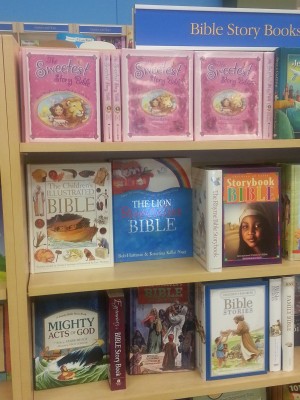 When you’re shopping for a new Bible storybook for your child or grandchild, the number of options can feel overwhelming. How do you decide?
When you’re shopping for a new Bible storybook for your child or grandchild, the number of options can feel overwhelming. How do you decide?
Here are 5 tips to help you sort through all the possibilities, whether you’re at a bookstore or online.
1. Match the text, illustration, and format to your child’s age and interests.
Babies and toddlers enjoy board books because they can turn the pages themselves.
Books with long stories and more text than illustration are best for older children.
Most Bible storybooks for preschoolers and beginning readers fall somewhere in between.
Children generally respond well to bright colors and a range of contemporary illustration styles—but contemporary doesn’t have to mean inaccurate.
Older children can appreciate more realistic portrayals of Bible times.
2. Look at the Contents page.
Are both Old and New Testament stories well represented? Do the stories present the overall story arc of the whole Bible, from Genesis to Revelation?
3. Read a story or two aloud.
You’ll be reading from this Bible storybook often. The experience should be a pleasant one for your child and for you too.
Does the writing flow well, with interesting rhythms? Is the writing style appropriate for your child’s age and attention span?
Do you want a straightforward retelling of the stories or a freer style with more embellishments? Both exist and both can be done with excellence, but it’s important to know the difference.
4. Check out how the author handles hard topics.
The Bible addresses some realities beyond the understanding of young children, such as the devastation of the flood, the total destruction of Jericho, or the details of Jesus’ suffering and crucifixion. Choose a Bible storybook that presents truths like these in age-appropriate ways.
For example, in my Bible storybook God’s Words to Dream On, in the story of the fall of Jericho, I didn’t write about the battle after the walls fell down. Instead I ended the story by commenting that the Israelites could now keep moving forward into the Promised Land God was giving them.
5. Choose the right “hook” for your child or your family.
Some Bible storybooks feature activity ideas or talking points to go along with each story—especially helpful to busy parents or if you are and unfamiliar with the Bible yourself.
New or beginning readers might want stories they can read with little or no help.
Sometimes the hook might be application, or life lessons. But be careful—when Bible stories are presented only as lessons about how to behave, children often get the wrong message and decide that good behavior is the way to find acceptance with God.
Now that you know what to look for, I hope you’ll enjoy reading a new Bible storybook with your child soon.
Does your child have a favorite Bible storybook?
Share it with others in the comments below.

2 Responses to “Start Here: How to Choose a Bible Storybook”